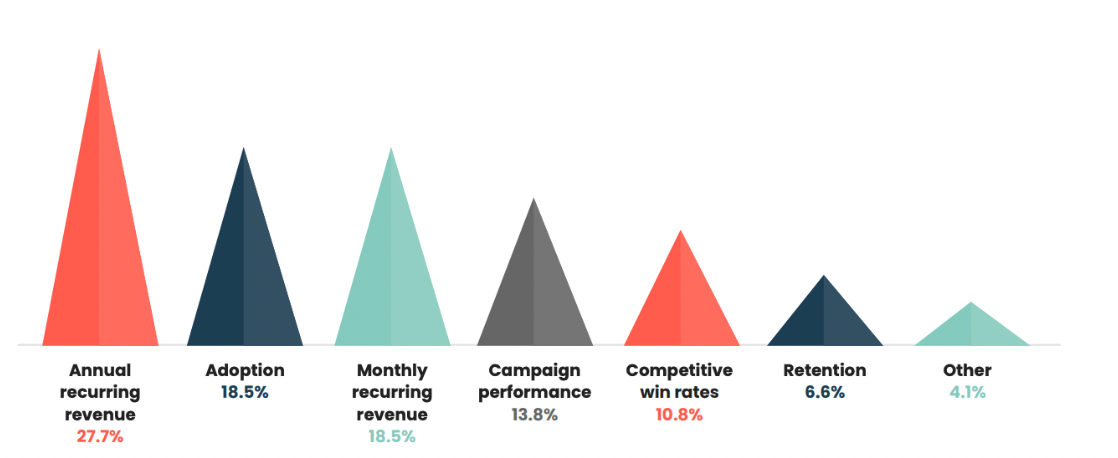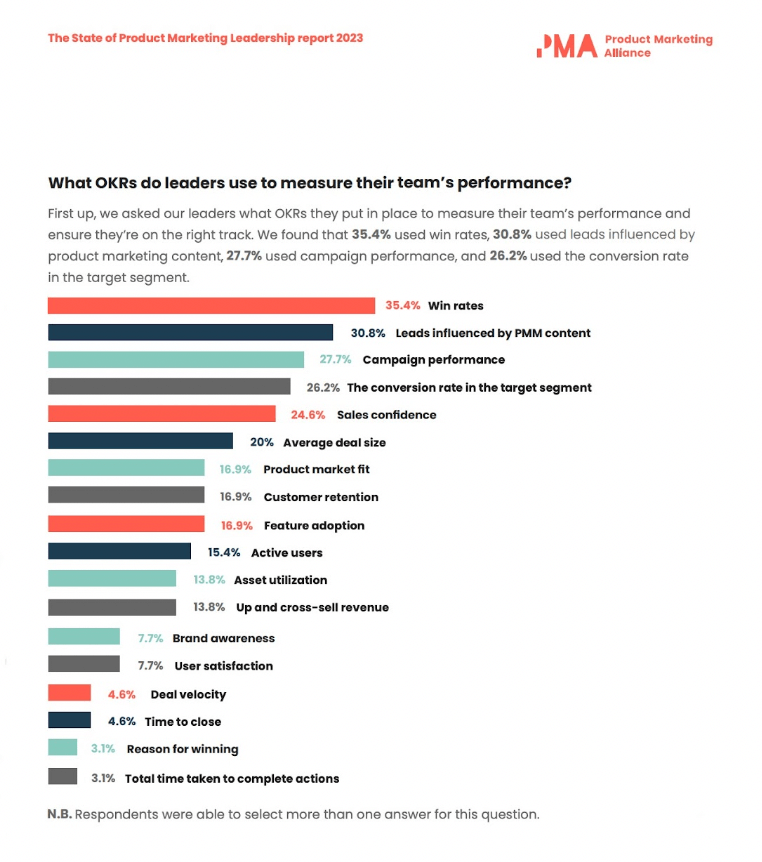This article is based on Devon and Erica’s discussion at the Product Marketing Summit in Denver, 2023. Product Marketing Alliance members can watch the session in its full glory here.
In this article, we'll be diving into the realm of product marketing, examining its strategic functions, and exploring how we can leverage it to achieve OKRs.
We'll also delve into some key metrics that are currently being used to measure product marketing's effectiveness. However, we need to acknowledge up front that there's no definitive blueprint for measuring success in this area.
First, let us introduce ourselves. We’re Devon O'Rourke, Founder and Managing Partner of Fluvio, and Erica Foster, Senior Product Marketing Consultant at Fluvio – a product marketing consulting firm.
We work hand in hand with various companies and get an inside view of the strategies and metrics tech companies are using to measure product marketing. And being a consulting company, we're often asked about our performance – as we’re sure you are too.
During this piece, we’ll hone in specifically on:
- How product marketing teams measure their success
- Sharing success metrics with other teams
- How to ensure you hit your goals
- How to get ongoing stakeholder buy-in
How product marketing teams measure their success
As a starting point, let's take a look at the recent State of Product Marketing Leadership Report. This resource presents a wealth of data on how product marketing is measured.
We're particularly interested in how leaders tie product marketing to revenue. The report finds that annual recurring revenue, product adoption, and monthly recurring revenue top the list of OKRs linking product marketing to revenue.

We’re happy to see that annual recurring revenue is the number-one way that product marketing teams measure their revenue impact. It's broad, but the impact of our work often takes over a year to become apparent to the business, so it's challenging to tie our efforts to anything less substantial than that.
It's no surprise that revenue emerges as such a significant focus for PMMs. However, working with a broad spectrum of products and industries, we’ve seen that the methods clients use to connect revenue to product marketing vary a lot. We've seen anything from personas linked to leads, to sales enablement programs tied to closed deals.
Adoption is another interesting metric to focus on because it can be interpreted in so many different ways.
For instance, are we discussing feature adoption or product usage – perhaps through MAU/DAU metrics (monthly average users to daily average users)? Regardless of the interpretation, it's clear why adoption has a secure spot on this list.
Now, depending on whether you're reporting into the product or marketing team, your perspective on metrics can change pretty dramatically. If you're rolling into a product team, you're likely looking at things like product adoption metrics or usage metrics.
In this setup, you not only have access to that data but also collaborate closely with product teams. These teams are invested in your success and stand by you during product launches. They help you understand release timelines or anything that might impact your launch.
But let's be clear; this isn't always the case. If you're part of a marketing team, your success metrics and partnerships could look very different.
Not only does your reporting structure influence your success criteria, but your business model plays a part too. Whether you’re in a B2B or a B2C product marketing org affects how you gauge success.
In B2C, it can be quite a struggle to track your success as a product marketer. In our experience, it’s much easier for B2B product marketing orgs to show and articulate their value; it's generally tied to some sort of revenue goal or win rates, which can easily be broken down and measured.
Meanwhile, in B2C you have to attach product marketing’s success to that of other partner teams – even more so than in B2B.
Sharing success metrics with other teams
Regardless of the business model, shared metrics among different teams are common. A good example is the win/loss metric. Product marketing often uses this as a success metric, but it's heavily influenced by the sales team. In fact, there aren't many pure product marketing metrics tied to success.
All this leads us to one question: can we measure success purely from a product marketing perspective?
It’s a tough one. Everything we do relies on other teams. That's why it’s so important to develop soft skills like emotional intelligence and collaboration. All these other teams are our extended arms – we can't really achieve anything without them.

Here’s another interesting graph from the State of Product Marketing Leadership Report. It focuses on the OKRs that leaders use to measure team performance, with win rates and leads influenced by PMM content coming out on top.
It's intriguing to see these metrics up there – particularly leads influenced by PMM content, which is challenging to measure. So much of our content revolves around internal messaging frameworks. How do you measure the use of your messaging and its direct impact on something like a sale?
One way is through gated content, which offers some potential for attribution. We could also look at things like downloads and, if the sales team uses specific types of content within their sales cycle, attempt to correlate downloads to content use. This approach is a bit like piecing together a puzzle, but it's a start. We need to get creative when thinking about how product marketing is influencing leads.
Another surprisingly popular metric for PMMs is the average deal size, which is a priority for 20% of businesses. Now is a particularly pertinent time to focus on this metric, given the current market trends.
We’ve been seeing more and more companies reconsidering their packaging and pricing. They're aware that lead growth might be stagnant at the moment, so the goal becomes to effectively close the leads you do get and then maximize those revenue opportunities.
As part of the trend for revamping packaging and pricing strategies, many companies are also reducing choice somewhat, and emphasizing value-based buying over ad-hoc purchases.
As a company matures, it naturally ends up with a sprawling range of 20 to 30 products with various functionalities. Some products need to be used together, others don't, and it can quickly turn into a convoluted matrix. This is something we all need to keep an eye on.
How to ensure you hit your goals
Interestingly, the State of Product Marketing Leadership Report shows that PMMs are pretty confident that they’ll meet their KPIs this year – the average score out of 10 is 7.4.
This is all the more intriguing because our work is so strongly influenced by our cross-functional partners, so we can’t always be truly confident that our actions specifically will impact those metrics. We can, however, be confident in the quality of our work and the output we produce, hoping that they influence these metrics.
For us, the best practice to increase the likelihood that you’ll hit your KPIs involves several five steps. Let’s take a look.
Step one: Build alignment with the executive team
When our clients ask us about performance measurement, we always tell them to look at what their business cares about over the next year. There are likely one or two big things product marketing teams can align with – let's concentrate on those macro priorities.
We've identified four potential priority areas for businesses, each with three or four corresponding metrics for product marketing to adopt:
Go-to-market
- Win rates
- Conversion rate
- Analyst coverage/position
Sales enablement and effectiveness
- Asset utilization
- Average deal size
- Deal cycles
- Win/loss ratio
Top-of-funnel marketing
- Campaign performance
- Site traffic
- MQLs and SQLs
Product adoption
- Feature adoption
- Churn rate
Hopefully, these focus areas and metrics are a useful starting point if you’re revisiting your team’s OKRs.
Step two: Share your plan with the executive team
Once you’ve aligned the product marketing team’s OKRs with the broader business goals, it’s time to present your plans and rationale to the executive team, making sure that they agree and essentially endorse your plan.
We’d also recommend producing a document or readout that outlines roles, responsibilities, product marketing goals, and metrics.
Step three: Socialize your plan
Once you’ve formulated and documented your product marketing plan, do a little roadshow. This involves a couple of weeks of attending different department meetings, sharing your plan, and ensuring everyone understands what you're tracking and why.
Step four: Establish tracking mechanisms
There are various tools you can use to monitor metrics, so do your research and set up the one that makes most sense for your business.
Step five: Build accountability
It’s so important to hold yourself accountable for progressing towards your goals, perhaps with a quarterly report. We do that internally, producing a report each quarter that shares both successes and areas for improvement.
Tracking against our goals, maintaining accountability, and sharing results – perhaps even oversharing – has worked very well in helping us hit our targets.
How to get ongoing stakeholder buy-in
Linking the work of PMMs with stakeholder OKRs is a big deal. We often see this when our clients ask us to establish go-to-market processes – our role there isn't just creating the process, but also getting everyone on board and excited about the journey.
To get that continued buy-in, you need some metrics to show that your new processes are working.
One way to approach this is with product metrics. Our job as product marketers is to help our PM colleagues tell their stories to the world. They've put a ton of effort into building a feature or product, and we can help spread the word and drive product adoption with new and existing customers.
Showing product teams how we can drive that market penetration can really open their eyes to the power of product marketing.
Think about things like how many new customers are using the feature and what kind of value they're getting from it, or how existing customers are adopting the new feature. These are the kinds of adoption metrics we can use for product launches, and they can help the product team understand our influence.
We’d recommend taking a similar approach to each one of your stakeholder teams. As long as you show how product marketing can support them in achieving their goals, they’re sure to support you right back.
How to take a more strategic approach to product marketing
There’s no perfect answer to the question of how to be more strategic and less reactive as a PMM within a company. Often, it boils down to company culture and having the right people onboard.
In some companies, product marketing is highly valued and given a seat at the table – often when someone in the C-suite has a background in product marketing or has had a positive experience with product marketing teams.
However, we've also worked with some outwardly successful companies that don't share this view. In this kind of company, it's very easy to fall into a pattern of being reactive. That’s because we want to provide value so we say, “Yes, sales, we can do that for you,” or, “Yes, product team, it's okay if we delay the launch by a week,” (even when it's really not!)
To make sure you’re focusing your effort where it counts, it’s a good idea to dedicate 80% of your time to strategic projects and leave 20% for ad hoc tasks that are going to move the needle for your cross-functional partners.
If you fiercely prioritize the big strategic projects, people will start to see the value you're bringing to the company – and they might even stop coming to you with so many small tactical requests.


















 Follow us on LinkedIn
Follow us on LinkedIn



.svg?v=a4be9bcc7d)